2003 NISSAN 350Z coolant level
[x] Cancel search: coolant levelPage 152 of 227
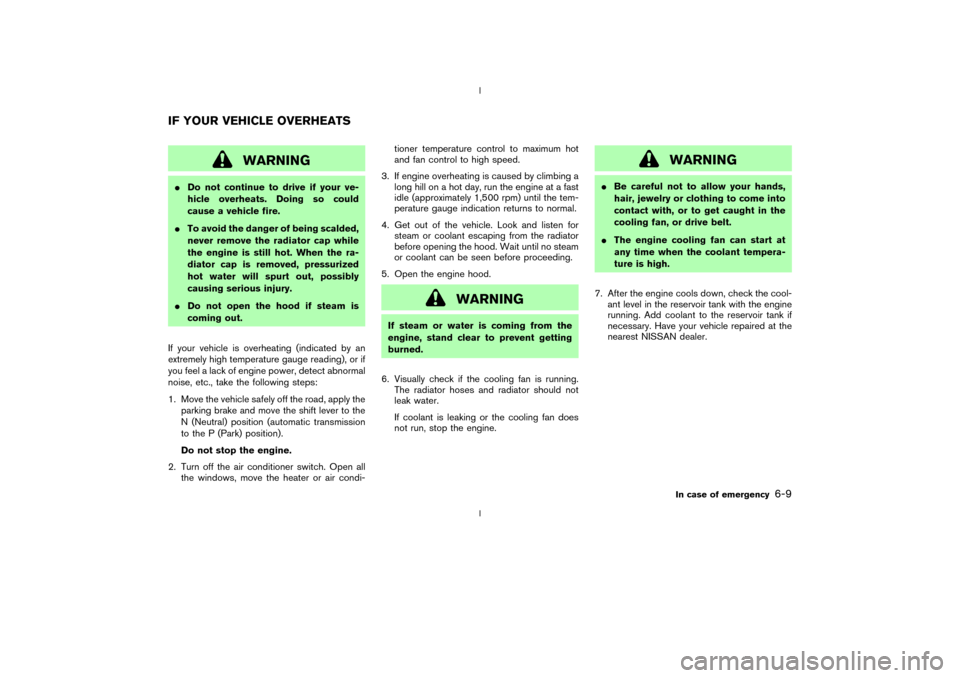
WARNING
IDo not continue to drive if your ve-
hicle overheats. Doing so could
cause a vehicle fire.
ITo avoid the danger of being scalded,
never remove the radiator cap while
the engine is still hot. When the ra-
diator cap is removed, pressurized
hot water will spurt out, possibly
causing serious injury.
IDo not open the hood if steam is
coming out.
If your vehicle is overheating (indicated by an
extremely high temperature gauge reading), or if
you feel a lack of engine power, detect abnormal
noise, etc., take the following steps:
1. Move the vehicle safely off the road, apply the
parking brake and move the shift lever to the
N (Neutral) position (automatic transmission
to the P (Park) position).
Do not stop the engine.
2. Turn off the air conditioner switch. Open all
the windows, move the heater or air condi-tioner temperature control to maximum hot
and fan control to high speed.
3. If engine overheating is caused by climbing a
long hill on a hot day, run the engine at a fast
idle (approximately 1,500 rpm) until the tem-
perature gauge indication returns to normal.
4. Get out of the vehicle. Look and listen for
steam or coolant escaping from the radiator
before opening the hood. Wait until no steam
or coolant can be seen before proceeding.
5. Open the engine hood.
WARNING
If steam or water is coming from the
engine, stand clear to prevent getting
burned.
6. Visually check if the cooling fan is running.
The radiator hoses and radiator should not
leak water.
If coolant is leaking or the cooling fan does
not run, stop the engine.
WARNING
IBe careful not to allow your hands,
hair, jewelry or clothing to come into
contact with, or to get caught in the
cooling fan, or drive belt.
IThe engine cooling fan can start at
any time when the coolant tempera-
ture is high.
7. After the engine cools down, check the cool-
ant level in the reservoir tank with the engine
running. Add coolant to the reservoir tank if
necessary. Have your vehicle repaired at the
nearest NISSAN dealer.
IF YOUR VEHICLE OVERHEATS
In case of emergency
6-9
Z
02.9.13/Z33-D/V5.0
X
Page 162 of 227

8 Maintenance and do-it-yourselfMaintenance requirements .................................................. 8-2
General maintenance ............................................................ 8-2
Explanation of general maintenance items ................ 8-2
Maintenance precautions ..................................................... 8-5
Engine compartment check locations .............................. 8-7
Engine cooling system.......................................................... 8-8
Checking engine coolant level...................................... 8-8
Changing engine coolant ............................................... 8-9
Engine oil ............................................................................... 8-10
Checking engine oil level ............................................ 8-10
Changing engine oil and filter .................................... 8-10
Automatic transmission fluid ............................................. 8-12
Power steering fluid ............................................................ 8-13
Brake and clutch fluid ........................................................ 8-13
Brake fluid ....................................................................... 8-13
Clutch fluid ...................................................................... 8-14
Window washer fluid.......................................................... 8-14
Battery .................................................................................... 8-15
Jump starting .................................................................. 8-16
Drive belts ............................................................................. 8-17
Spark plugs ........................................................................... 8-17Replacing spark plugs.................................................. 8-17
Air cleaner ............................................................................. 8-18
Windshield wiper blades ................................................... 8-19
Cleaning ........................................................................... 8-19
Replacing ......................................................................... 8-20
Parking brake and brake pedal ........................................ 8-21
Checking parking brake ............................................... 8-21
Checking brake pedal .................................................. 8-21
Brake booster ................................................................. 8-22
Fuses ...................................................................................... 8-22
Engine compartment ..................................................... 8-22
Passenger compartment .............................................. 8-23
Keyfob battery replacement .............................................. 8-24
Lights ...................................................................................... 8-25
Headlights ....................................................................... 8-26
Exterior and interior lights............................................ 8-27
Wheels and tires ................................................................. 8-29
Tire pressure ................................................................... 8-29
Types of tires .................................................................. 8-30
Tire chains ....................................................................... 8-31
Changing wheels and tires ......................................... 8-31
Z
02.9.13/Z33-D/V5.0
X
Page 165 of 227

Automatic transmission P (Park) position
mechanism:On a fairly steep hill check that the
vehicle is held securely with the selector lever in
the P (Park) position without applying any
brakes.Under the hood and the vehicleThe maintenance items listed here should be
checked periodically (for example, each time you
check the engine oil or refuel).
Windshield washer fluid*:Check that there is
adequate fluid in the tank.
Engine coolant level*:Check the coolant level
when the engine is cold.
Radiator and hoses:Check the front of the
radiator and clean off any dirt, insects, leaves,
etc., that may have accumulated. Make sure the
hoses have no cracks, deformation, deterioration
or loose connections.
Brake and clutch fluid levels*:Make sure that
the brake and clutch fluid levels are between the
MAX and MIN lines on the reservoir.
Battery*:Check the fluid level in each cell. It
should be between the MAX and MIN lines.
Vehicles operated in high temperatures or under
severe conditions require frequent checks of the
battery fluid level.
Engine drive belts*:Make sure that no belt isfrayed, worn, cracked or oily.
Engine oil level*:Check the level on the
dipstick after parking the vehicle on a level spot,
turning off the engine and waiting 10 minutes.
Power steering fluid level* and lines:Check
the level in the reservoir tank with the engine off.
Check the lines for proper attachment, leaks,
cracks, etc.
Exhaust system:Make sure there are no loose
supports, cracks or holes. If the sound of the
exhaust seems unusual or there is a smell of
exhaust fumes, immediately locate the trouble
and correct it. (See ªPrecautions when starting
and drivingº in the ª5. Starting and drivingº
section for exhaust gas (carbon monoxide).)
Underbody:The underbody is frequently ex-
posed to corrosive substances such as those
used on icy roads or to control dust. It is very
important to remove these substances, other-
wise rust will form on the floor pan, frame, fuel
lines and around the exhaust system. At the end
of winter, the underbody should be thoroughly
flushed with plain water, being careful to clean
those areas where mud and dirt may accumu-
late. For additional information, see ªCleaning
exteriorº in the ª7. Appearance and careº sec-
tion.
Fluid leaks:Check under the vehicle for fuel,oil, water or other fluid leaks after the vehicle has
been parked for a while. Water dripping from the
air conditioner after use is normal. If you should
notice any leaks or if gasoline fumes are evident,
check for the cause and have it corrected imme-
diately.8-4
Maintenance and do-it-yourself
Z
02.9.13/Z33-D/V5.0
X
Page 166 of 227
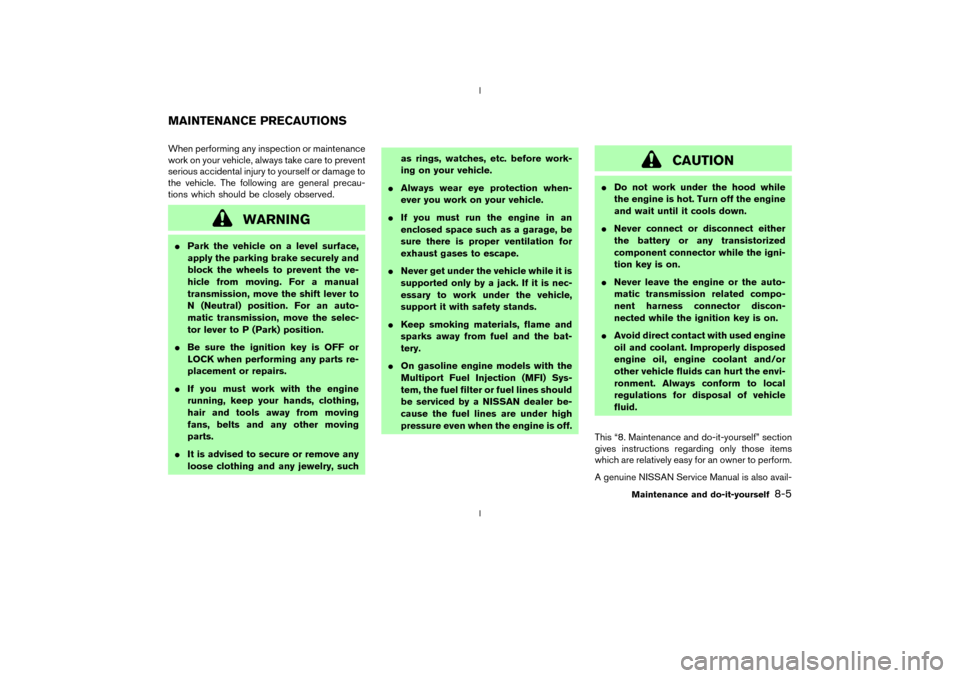
When performing any inspection or maintenance
work on your vehicle, always take care to prevent
serious accidental injury to yourself or damage to
the vehicle. The following are general precau-
tions which should be closely observed.
WARNING
IPark the vehicle on a level surface,
apply the parking brake securely and
block the wheels to prevent the ve-
hicle from moving. For a manual
transmission, move the shift lever to
N (Neutral) position. For an auto-
matic transmission, move the selec-
tor lever to P (Park) position.
IBe sure the ignition key is OFF or
LOCK when performing any parts re-
placement or repairs.
IIf you must work with the engine
running, keep your hands, clothing,
hair and tools away from moving
fans, belts and any other moving
parts.
IIt is advised to secure or remove any
loose clothing and any jewelry, suchas rings, watches, etc. before work-
ing on your vehicle.
IAlways wear eye protection when-
ever you work on your vehicle.
IIf you must run the engine in an
enclosed space such as a garage, be
sure there is proper ventilation for
exhaust gases to escape.
INever get under the vehicle while it is
supported only by a jack. If it is nec-
essary to work under the vehicle,
support it with safety stands.
IKeep smoking materials, flame and
sparks away from fuel and the bat-
tery.
IOn gasoline engine models with the
Multiport Fuel Injection (MFI) Sys-
tem, the fuel filter or fuel lines should
be serviced by a NISSAN dealer be-
cause the fuel lines are under high
pressure even when the engine is off.
CAUTION
IDo not work under the hood while
the engine is hot. Turn off the engine
and wait until it cools down.
INever connect or disconnect either
the battery or any transistorized
component connector while the igni-
tion key is on.
INever leave the engine or the auto-
matic transmission related compo-
nent harness connector discon-
nected while the ignition key is on.
IAvoid direct contact with used engine
oil and coolant. Improperly disposed
engine oil, engine coolant and/or
other vehicle fluids can hurt the envi-
ronment. Always conform to local
regulations for disposal of vehicle
fluid.
This ª8. Maintenance and do-it-yourselfº section
gives instructions regarding only those items
which are relatively easy for an owner to perform.
A genuine NISSAN Service Manual is also avail-
MAINTENANCE PRECAUTIONS
Maintenance and do-it-yourself
8-5
Z
02.9.13/Z33-D/V5.0
X
Page 169 of 227
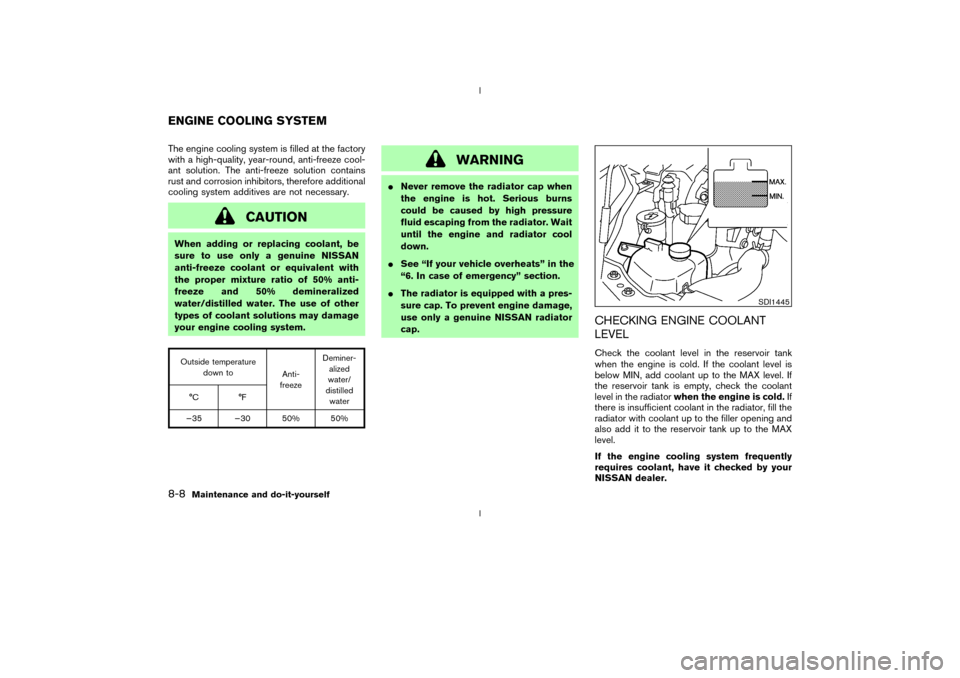
The engine cooling system is filled at the factory
with a high-quality, year-round, anti-freeze cool-
ant solution. The anti-freeze solution contains
rust and corrosion inhibitors, therefore additional
cooling system additives are not necessary.
CAUTION
When adding or replacing coolant, be
sure to use only a genuine NISSAN
anti-freeze coolant or equivalent with
the proper mixture ratio of 50% anti-
freeze and 50% demineralized
water/distilled water. The use of other
types of coolant solutions may damage
your engine cooling system.Outside temperature
down to
Anti-
freezeDeminer-
alized
water/
distilled
water ÉC ÉF
þ35 þ30 50% 50%
WARNING
INever remove the radiator cap when
the engine is hot. Serious burns
could be caused by high pressure
fluid escaping from the radiator. Wait
until the engine and radiator cool
down.
ISee ªIf your vehicle overheatsº in the
ª6. In case of emergencyº section.
IThe radiator is equipped with a pres-
sure cap. To prevent engine damage,
use only a genuine NISSAN radiator
cap.
CHECKING ENGINE COOLANT
LEVELCheck the coolant level in the reservoir tank
when the engine is cold. If the coolant level is
below MIN, add coolant up to the MAX level. If
the reservoir tank is empty, check the coolant
level in the radiatorwhen the engine is cold.If
there is insufficient coolant in the radiator, fill the
radiator with coolant up to the filler opening and
also add it to the reservoir tank up to the MAX
level.
If the engine cooling system frequently
requires coolant, have it checked by your
NISSAN dealer.
SDI1445
ENGINE COOLING SYSTEM8-8
Maintenance and do-it-yourself
Z
02.9.13/Z33-D/V5.0
X
Page 170 of 227
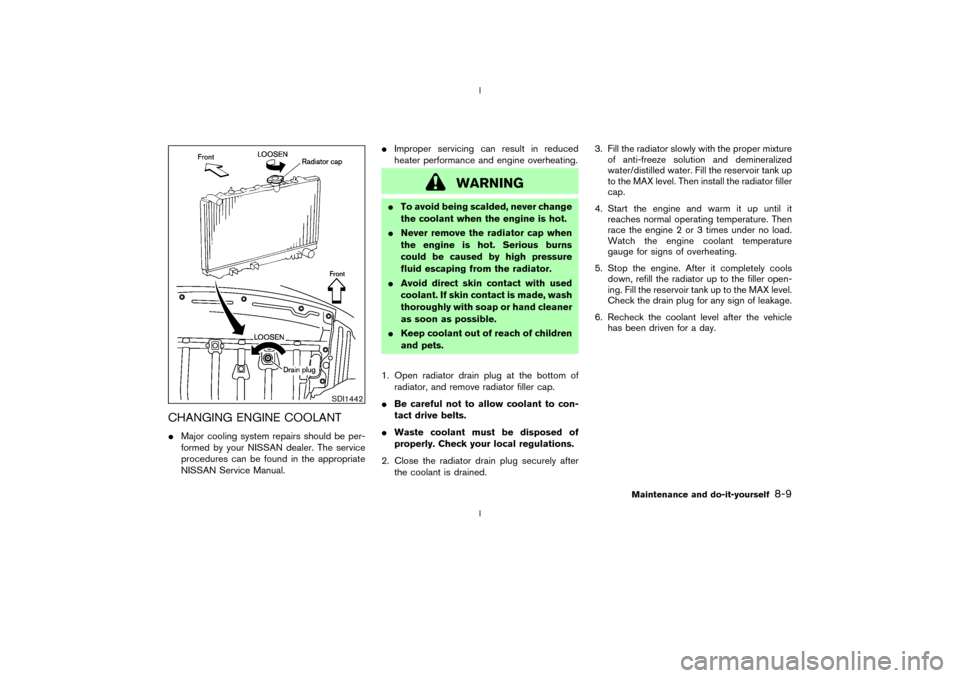
CHANGING ENGINE COOLANTIMajor cooling system repairs should be per-
formed by your NISSAN dealer. The service
procedures can be found in the appropriate
NISSAN Service Manual.IImproper servicing can result in reduced
heater performance and engine overheating.
WARNING
ITo avoid being scalded, never change
the coolant when the engine is hot.
INever remove the radiator cap when
the engine is hot. Serious burns
could be caused by high pressure
fluid escaping from the radiator.
IAvoid direct skin contact with used
coolant. If skin contact is made, wash
thoroughly with soap or hand cleaner
as soon as possible.
IKeep coolant out of reach of children
and pets.
1. Open radiator drain plug at the bottom of
radiator, and remove radiator filler cap.
IBe careful not to allow coolant to con-
tact drive belts.
IWaste coolant must be disposed of
properly. Check your local regulations.
2. Close the radiator drain plug securely after
the coolant is drained.3. Fill the radiator slowly with the proper mixture
of anti-freeze solution and demineralized
water/distilled water. Fill the reservoir tank up
to the MAX level. Then install the radiator filler
cap.
4. Start the engine and warm it up until it
reaches normal operating temperature. Then
race the engine 2 or 3 times under no load.
Watch the engine coolant temperature
gauge for signs of overheating.
5. Stop the engine. After it completely cools
down, refill the radiator up to the filler open-
ing. Fill the reservoir tank up to the MAX level.
Check the drain plug for any sign of leakage.
6. Recheck the coolant level after the vehicle
has been driven for a day.
SDI1442
Maintenance and do-it-yourself
8-9
Z
02.9.13/Z33-D/V5.0
X
Page 197 of 227

The following are approximate capacities. The actual refill capacities may be a little different. When refilling, follow the procedure
instructed in the ª8. Maintenance and do-it-yourselfº section to determine the proper refill capacity.
Capacity (Approximate)
Recommended
specifications US
measureImp
measureLiter
Fuel 20 gal 16-5/8 gal 76 Unleaded premium gasoline with an octane rating of at least 91 AKI (RON 96)*1
Engine oil (Drain and refill)*2
With oil filter change 5 qt 4-1/8 qt 4.7IAPI Certification Mark*3, *4
IAPI grade SG/SH, Energy ConservingI&IIorAPIgrade SJ or SL, Energy
Conserving*3, *4
IILSAC grade GF-I, GF-II & GF-III*2, *3 Without oil filter change 4-5/8 qt 3-7/8 qt 4.4
Cooling system
With reservoir 9-1/4 qt 7-5/8 qt 8.7
Genuine NISSAN anti-freeze coolant or equivalent
Reservoir 7/8 qt 3/5 qt 0.8
Automatic transmission fluid Ð Ð Ð Genuine Nissan ATF Matic Fluid J or exact equivalent*5
Manual transmission gear oil Ð Ð Ð API GL-4, Viscosity SAE 75W-85
Differential gear oil Ð Ð Ð API GL-5, Viscosity SAE 80W-90*6
Power steering fluid
Refill to the proper oil level according to the instructions in
the ª8. Maintenance and do-it-yourselfº section.Genuine Nissan PSF II or equivalent*7
Brake and clutch fluidGenuine Nissan Brake Fluid*8 or equivalent DOT 3 (U.S. FMVSS No. 116)
Multi-purpose grease Ð Ð Ð NLGI No. 2 (Lithium soap base)
Air conditioning system refrigerant Ð Ð Ð HFC-134a (R-134a)*9
Air conditioning system lubricants Ð Ð Ð Nissan A/C System Oil Type S or exact equivalent
*1: For additional information, see ªFuel recommendationº later in this chapter.
*2: For additional information, see ªEngine oilº in the ª8. Maintenance and do-it-yourselfº section for changing engine oil.
*3: For additional information, see ªEngine oil and oil filter recommendationº later in this chapter.
*4: For additional information, see ªRecommended SAE viscosity numberº later in this chapter.
*5: Using automatic transmission fluid other than Nissan Genuine ATF Matic Fluid J will cause deterioration in driveability and automatic transmission durability, and may
damage the automatic transmission, which is not covered by the NISSAN new vehicle limited warranty.
*6: For hot areas, viscosity SAE 90 is suitable for ambient temperatures above 32ÉF (0ÉC).
*7: Genuine Nissan PSF, Canada Nissan Automatic Transmission fluid, Dexron
TMIII/Mercon
TMor equivalent ATF may also be used.
*8: Available in mainland US through your NISSAN dealer.
*9: For additional information, see ªVehicle identificationº in this section for air conditioner specification label.
CAPACITIES AND
RECOMMENDED FUEL/
LUBRICANTS9-2
Technical and consumer information
Z
02.9.13/Z33-D/V5.0
X
Page 221 of 227
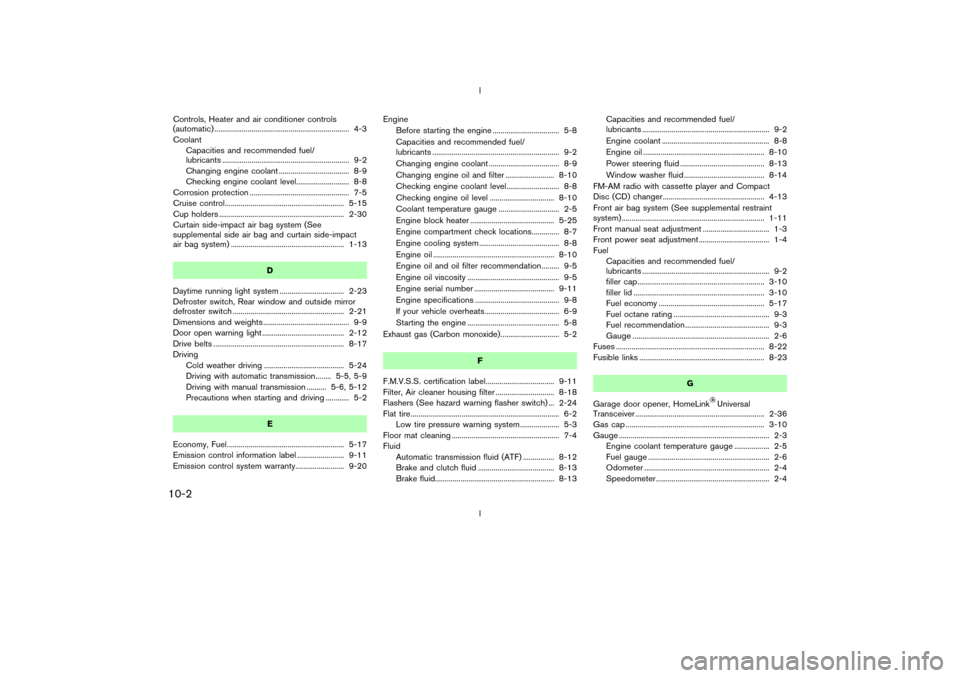
Controls, Heater and air conditioner controls
(automatic) ..................................................................... 4-3
Coolant
Capacities and recommended fuel/
lubricants ................................................................. 9-2
Changing engine coolant .................................... 8-9
Checking engine coolant level........................... 8-8
Corrosion protection ................................................... 7-5
Cruise control............................................................. 5-15
Cup holders ................................................................ 2-30
Curtain side-impact air bag system (See
supplemental side air bag and curtain side-impact
air bag system) .......................................................... 1-13
D
Daytime running light system ................................. 2-23
Defroster switch, Rear window and outside mirror
defroster switch ......................................................... 2-21
Dimensions and weights ............................................ 9-9
Door open warning light .......................................... 2-12
Drive belts ................................................................... 8-17
Driving
Cold weather driving ......................................... 5-24
Driving with automatic transmission........ 5-5, 5-9
Driving with manual transmission .......... 5-6, 5-12
Precautions when starting and driving ............ 5-2
E
Economy, Fuel............................................................ 5-17
Emission control information label ........................ 9-11
Emission control system warranty......................... 9-20Engine
Before starting the engine .................................. 5-8
Capacities and recommended fuel/
lubricants ................................................................. 9-2
Changing engine coolant .................................... 8-9
Changing engine oil and filter ......................... 8-10
Checking engine coolant level........................... 8-8
Checking engine oil level ................................. 8-10
Coolant temperature gauge ............................... 2-5
Engine block heater ........................................... 5-25
Engine compartment check locations.............. 8-7
Engine cooling system ......................................... 8-8
Engine oil .............................................................. 8-10
Engine oil and oil filter recommendation......... 9-5
Engine oil viscosity ............................................... 9-5
Engine serial number ......................................... 9-11
Engine specifications ........................................... 9-8
If your vehicle overheats ...................................... 6-9
Starting the engine ............................................... 5-8
Exhaust gas (Carbon monoxide).............................. 5-2
F
F.M.V.S.S. certification label................................... 9-11
Filter, Air cleaner housing filter .............................. 8-18
Flashers (See hazard warning flasher switch) ... 2-24
Flat tire............................................................................ 6-2
Low tire pressure warning system .................... 5-3
Floor mat cleaning ....................................................... 7-4
Fluid
Automatic transmission fluid (ATF) ................ 8-12
Brake and clutch fluid ....................................... 8-13
Brake fluid............................................................. 8-13Capacities and recommended fuel/
lubricants ................................................................. 9-2
Engine coolant ....................................................... 8-8
Engine oil .............................................................. 8-10
Power steering fluid ........................................... 8-13
Window washer fluid ......................................... 8-14
FM-AM radio with cassette player and Compact
Disc (CD) changer.................................................... 4-13
Front air bag system (See supplemental restraint
system) ......................................................................... 1-11
Front manual seat adjustment .................................. 1-3
Front power seat adjustment .................................... 1-4
Fuel
Capacities and recommended fuel/
lubricants ................................................................. 9-2
filler cap................................................................. 3-10
filler lid ................................................................... 3-10
Fuel economy ...................................................... 5-17
Fuel octane rating ................................................. 9-3
Fuel recommendation ........................................... 9-3
Gauge ...................................................................... 2-6
Fuses ............................................................................ 8-22
Fusible links ................................................................ 8-23
G
Garage door opener, HomeLink
Universal
Transceiver .................................................................. 2-36
Gas cap ....................................................................... 3-10
Gauge ............................................................................. 2-3
Engine coolant temperature gauge .................. 2-5
Fuel gauge .............................................................. 2-6
Odometer ................................................................ 2-4
Speedometer .......................................................... 2-4
Z
02.9.13/Z33-D/V5.0
X
10-2